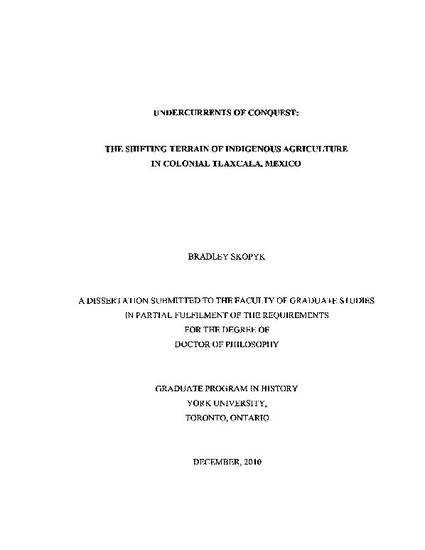
Dissertation
Undercurrents_of_conquest_The.pdf
(2010)
Abstract
Interactions between Spanish and indigenous biota had far-reaching environmental and social consequences in colonial Mexico. Approaches to this problem generally focus on sixteenth-century processes and biotic invaders (i.e. Spaniards and Old World biota) and neglect how indigenous persons mediated the biotic encounter and shaped its outcome. Indigenous farmers dominated demographically, constituted New Spain’s agrarian workforce and cultivated fragile hill-side terrain. How, then, did indigenous farmers use and manage exotic organisms within their agrosystems? How did they adapt native species to the new colonial and biotic context? And moreover, how did the ecology of newly-constructed indigenous agrosystems withstand periods of extreme climatic, demographic and economic volatility? This study of colonial Tlaxcala’s environmental history helps to answer these questions by examining the dynamics and sustainability of indigenous agroecosystems. Historical annals, wills, land titles and government records in Nahuatl and Spanish, and litigation and chronicles in Spanish, show the components of indigenous agroecosystems and the ebbs and flows of powerful social and environmental forces. A reconstruction of hydrological change and land degradation reveals the effects and timing of environmental change.
The history of sixteenth-century Tlaxcala demonstrates that despite widespread Old World biotic diffusion, massive land abandonment and Spanish estate development, environmental disaster failed to occur. Hydrology changed little and land did not degrade, while grasslands and forests regenerated. The ecology of indigenous agriculture explains this paradox. Biologically diverse, pyrogenic and locally-constituted agroecosystems favoured regeneration over degradation. By the eighteenth century, however, Tlaxcala’s hydrology had transformed and soil degradation peaked during the climatic and demographic crisis of 1690-1710. Climate change, viceregal policy and Old World draught animals (oxen and mules) encouraged indigenous farmers to cultivate maguey for pulque (alcohol) production. The new agrosystem—monocropped, dependent upon volatile distant markets and extensively dispersed on exposed hill-sides—lacked resiliency when faced with crises and recklessly exposed soils to degradation. Furthermore, these climatic and ecological processes help to explain rising social conflict and changing perceptions of ethnicity and landscape. Such findings make indigenous persons and plants critical forces of social and environmental change, challenge Spanish-centred explanations of the biotic encounter and reveal new historical chronologies and processes.
Keywords
- Mexico,
- History,
- Environmental History,
- Latin American History,
- Colonial Mexican History
Disciplines
Publication Date
2010
Degree
PhD
Field of study
Environmental History, Latin American History
Department
Department of History
Advisors
Richard Hoffmann, Anne Rubenstein, Sonya Lipsett-Rivera
Citation Information
Bradley Skopyk. "Undercurrents_of_conquest_The.pdf" (2010) Available at: http://works.bepress.com/brad-skopyk/6/
